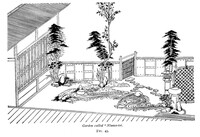There is a special style of composition, much in favour, called the "Tamagawa Tea garden." Of the six noted rivers in Japan bearing the name of Tamagawa (see page 100), some are specially distinguished for the flowers which bloom on their banks. The river at Toi in the province of Settsu is noted for its deutzias; that at Noji, in the province of Omi, for its lespedeza bushes; whilst the Tamagawa at Ide, in the province of Yamashiro, is famous for its kerria flowers. The application of the name to a class of Tea Gardens originated with Rosha, a famous Chajin, who built a Tea Room on the banks of the Tamagawa at Chofu, in the province of Musashi. A garden after this style always contains a narrow winding stream of clear running water, having a pebbly bed bordered with boulders, water plants, and water grasses. The stream may be either crossed by rude stepping stones, or spanned by a simple plank bridge as shown in Figure 49. At least one antique looking lantern, a water basin, a group of rocks,�including the indispensable "Guardian Stone,"�and a few trees and shrubs, constitute the principal features of such a garden. The level areas between these objects are traversed by the usual stepping stones arranged in a winding and irregular manner. Very often a Tea Garden of this type will be designed to resemble a mountain dell, with hills or banks surrounding it, the stream being constructed in imitation of a small torrent-bed, and the whole forming a romantic hollow a little below the level of the Tea Room. In certain ancient designs the six noted rivers were represented together in one garden by means of tiny streams branching from a spring, which formed their common source.

